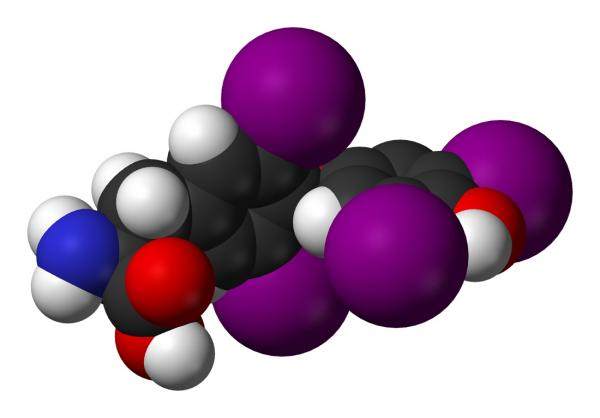Hyperthyroidism in cats – Symptoms and treatments

El feline hyperthyroidism It is one of those diseases that, in most cases, manages to go unnoticed, manifesting only when the cat’s health is seriously compromised.
It is a very common pathology, especially in cats that have exceeded the 7 years of age. In itself it is not deadly, but it entails complications that put the cat’s life at risk, by attacking several of its vital organs. That’s why he presents you this article about feline hyperthyroidism, symptoms and treatment. Keep reading!
What is feline hyperthyroidism?
It is a disease of which documentation is only available from 1970. It is common in elderly cats, especially in those that exceed the 10 years, being more frequent in the Siamese race.
It consists of an alteration of the organism due to overproduction of thyroid hormones (T3 and T4). Detected in time, there are high probabilities of control and improvement, but otherwise, the complications that accompany this excessive secretion of the hormone result deadly for the cat.

Causes of feline hyperthyroidism
The main cause of hyperthyroidism is the increase in the production of thyroid hormone, both T3 and T4. This increase is due, in most cases, to a disorder resulting from a disease related to thyroid lobes.
The cause is that, as the size of the lobes grows, product of the disease, the hormone begins to secrete larger quantities, affecting the balance of the entire organism.
Approximately in the 10% of felines affected, the disease is caused by the presence of a carcinoma (carcinogenic mass), in which case the prognosis for improvement is reduced.
Symptoms of hyperthyroidism in cats
One of the problems with hyperthyroidism is that, in most cases, there are no clear signs of disease, these begin to appear when the pathology has already advanced. This makes it necessary to remain alert to any abnormality in the comportamiento and habits of your cat, to detect this or any other illness in time.
Usually, the owner of the cat realizes that something is wrong when he notices that his partner eats the same or greater amounts of food, but shows an obvious pérdida peso.
This is accompanied by other alarming signs, as they are:
- Chronic diarrhea
- Depression
- Hyperactivity
- Nervous or coarse behavior
- Frequent vomiting
- Inability to jump
- Loss of strength
- Neglected and knotted mantle
- Arrhythmia
- Dyspnoea
- Disorientation
- Aggressiveness
- Unusual nocturnal vocalizations
These symptoms do not appear suddenly or appear together, rather they show up in a progressive, so if it is neglected it is possible that they are overlooked.
By increasing the secretion of the thyroid, kidney function is directly affected, so a kidney failure It is the greatest danger that runs, putting the cat’s life at risk.

How is the diagnosis made?
In principle, the size transformation of the thyroid lobes is usually noticeable with only feel the neck of the cat. This, of course, will not suffice to give a definitive diagnosis of hyperthyroidism, nor will the absence of this sign mean that the feline does not suffer from the disease.
To be sure, various medical tests are necessary. The most important of all is a complete blood test, in which you can appreciate not only the state of white blood cells and the health of the feline in general, but also the levels of liver enzymes (essential to detect a kidney problem).
In addition to this, a electrocardiogram to evaluate the possibility of a heart problem, such as arrhythmia and tachycardia.
Treatment of hyperthyroidism in cats
When the result of the studies shows a positive for feline hyperthyroidism, there are 3 types of treatments recommended. The choice of each depends not only on your country of residence, as one of them is not available worldwide, but also the age, weight and health status of the cat, as well as the possibility of liver complications or cardiac:
- The first option is administer antirust drugs, treatment that must be applied for life. The option is not curative, because it does not eliminate the origin of the problem, but it keeps the levels of thyroid hormone stable. It is possible that side effects occur, so veterinary reviews are recommended every 3 months to review the dose and adjust it if necessary.
- The second option is a thyroidectomy, which is nothing more than the removal of the thyroid. This measure usually eradicates much of the problem, although there is a fairly high mortality risk. Usually, a therapy with active ingredients is applied and then surgery is used, since in this way the lethality of the treatment is reduced. Do not opt for this solution if the cat suffers from liver disease or diabetes.
- The last possibility is the application of a treatment using radioactive iodine, which is considered the best option. However, it is not available in all countries, as it does not have nuclear medicine centers for pets.
With the radioactive iodine the tissue that has grown abnormally is removed, leaving the thyroid gland intact, and reducing the secretion levels of the hormone. The treatment is administered subcutaneously and it does not represent any risk; In addition, less than 10% of patients require a second dose, which is why it is highly effective.
There are pros and cons of applying each of these treatments, consulting with your veterinarian You can find the most suitable option for the feline.

This article is merely informative, in .com we do not have the faculty to prescribe veterinary treatments or make any kind of diagnosis. We invite you to take your pet to the veterinarian in case of any type of condition or discomfort.
If you want to read more articles similar to Hyperthyroidism in cats – Symptoms and treatments, we recommend that you enter in our section of Other health problems.


